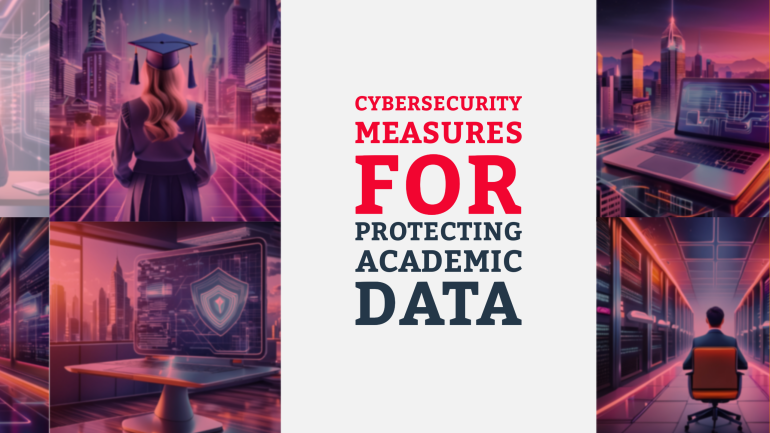Table of Contents
TL;DR: Cybersecurity Measures for Protecting Academic Data
- Implement Multi-Factor Authentication (MFA): It adds an extra layer of security by requiring users to provide two or more forms of verification before gaining access to protected systems or data.
- Regularly Update Software and Systems: Keep all software, including antivirus programs, up to date to protect against the latest cyber threats.
- Train Faculty and Staff on Cybersecurity Best Practices: Educate employees on how to identify and respond to potential security threats such as phishing emails or suspicious links.
- Monitor Network Traffic: Use intrusion detection systems to monitor network traffic for any signs of unauthorized access or unusual activity.
- Encrypt Sensitive Data: Encrypting data both at rest and in transit provides an additional layer of protection in case of a security breach.
Data breaches are becoming increasingly common in the digital age, and academic institutions are prime targets for cyberattacks. It is crucial for educational organizations to implement robust cybersecurity measures to safeguard sensitive academic data from unauthorized access and prevent costly breaches. From encrypting data and implementing multi-factor authentication to conducting regular security audits and employee training, there are various strategies that can be employed to enhance the protection of academic information. This blog post will research into key cybersecurity measures that academic institutions should prioritize to ensure the security and integrity of their data.
Understanding Academic Data and Its Value
While the academic world is predominantly focused on the pursuit of knowledge and innovation, it is crucial to recognize the immense value of academic data in today’s digital age. Academic data refers to any information generated, collected, or used within educational institutions, including research papers, student records, intellectual property, and administrative documents. This data holds significant importance to academic institutions, researchers, students, and external stakeholders due to its role in driving advancements in various fields of study.
Types of Academic Data
- Research papers: Publications and findings from academic research projects.
- Student records: Personal and academic information of students enrolled in academic programs.
- Intellectual property: Patents, copyright material, and trade secrets developed within academic institutions.
- Administrative documents: Institutional policies, financial records, and operational data.
Recognizing the diverse nature of academic data is imperative for understanding the value it holds and the potential risks associated with its exposure.
The Importance of Protecting Academic Information
An academic institution’s reputation and success depend significantly on the confidentiality, integrity, and availability of its data. Protecting academic information is crucial for maintaining trust among students, faculty, and stakeholders, safeguarding intellectual property, and complying with legal and ethical standards. Plus, a data breach can lead to severe consequences, including financial loss, reputational damage, regulatory penalties, and intellectual property theft. It is imperative for academic institutions to implement robust cybersecurity measures to ensure the protection of sensitive academic data.
Assessing the Cybersecurity Threat Landscape in Academia
Common Cyber Threats to Academic Institutions
One of the most common cyber threats facing academic institutions is phishing attacks. These malicious emails are designed to trick recipients into revealing sensitive information such as login credentials or financial details. Phishing attacks can lead to unauthorized access to academic systems and compromise the security of student and faculty data.
Statistics and Trends in Academic Data Breaches
Institutions must stay vigilant as academic data breaches are on the rise. According to recent statistics, there has been a significant increase in the number of data breaches affecting academic institutions. These breaches can result in the exposure of personal information, research data, and intellectual property, posing a serious threat to the academic community.
Data breaches in academia can have severe consequences, including financial losses, reputational damage, and legal ramifications. It is crucial for academic institutions to implement robust cybersecurity measures to protect against these evolving threats and safeguard sensitive data.
Cybersecurity Measures for Academic Institutions
Developing a Comprehensive Cybersecurity Strategy
One of the critical steps for academic institutions to protect their data is to develop a comprehensive cybersecurity strategy. This includes conducting regular risk assessments, identifying potential vulnerabilities, and implementing appropriate controls to mitigate cyber threats.
Technical Safeguards and Best Practices
Best practices for technical safeguards in academic institutions include implementing robust firewalls, using encryption for sensitive data, regularly updating software and systems, and restricting access to data on a need-to-know basis. These measures can help prevent unauthorized access and data breaches.
Another necessary aspect of technical safeguards is the use of multi-factor authentication (MFA) to add an extra layer of security when accessing sensitive information. By requiring multiple forms of verification, MFA greatly reduces the risk of unauthorized access.
Policies and Training
To ensure the effectiveness of cybersecurity measures, academic institutions must establish policies for data handling and conduct regular training sessions for faculty, staff, and students. These policies should cover data protection guidelines, password management, and incident response procedures.
Technical training programs can help educate users about potential threats such as phishing attacks, malware, and social engineering tactics. By increasing awareness and knowledge among stakeholders, academic institutions can strengthen their overall cybersecurity posture.
Incident Response and Recovery Planning
Preparing for Potential Cybersecurity Incidents
Recovery planning is a critical aspect of cybersecurity measures for protecting academic data. Being prepared for potential cyber incidents can significantly minimize the impact of breaches and data compromises. Establishing an incident response team, outlining escalation procedures, and conducting regular security drills are necessary components of proactive incident response planning.
Recovery Strategies for Compromised Academic Data
With the increasing sophistication of cyber threats, academia must have robust recovery strategies in place to safeguard academic data. In the event of a breach, timely identification, containment, eradication, and recovery of compromised data are vital. Implementing data backups, encryption protocols, and access controls are practical measures to aid in data recovery efforts.
It is imperative for academic institutions to prioritize incident response and recovery planning to mitigate the risks associated with cyber threats. By investing in proactive measures and having comprehensive strategies in place, institutions can effectively protect sensitive academic data and uphold the integrity of their digital assets.
Future Considerations in Cybersecurity for Academic Data
The Role of Emerging Technologies
Keep an eye on the evolving landscape of cybersecurity as emerging technologies such as artificial intelligence, machine learning, and blockchain play a crucial role in safeguarding academic data. These technologies offer advanced security measures like behavior analytics, anomaly detection, and encrypted transactions that can significantly enhance protection against cyber threats.
Collaborating to Improve Cybersecurity in Academia
Future collaborations between academic institutions, cybersecurity experts, and government agencies are paramount in strengthening cybersecurity measures for academic data. By sharing resources, best practices, and threat intelligence, these collaborations can bridge the gaps in security defenses and ensure a unified front against cyber attacks.
Academia must prioritize cybersecurity awareness and education at all levels to instill a culture of security among students, faculty, and staff. Establishing regular training programs, conducting simulated phishing exercises, and implementing multi-factor authentication are proactive measures that can build a robust defense against cyber threats.
To wrap up
Drawing together all the discussed cybersecurity measures for protecting academic data, it is clear that institutions must take a comprehensive approach to safeguard against cyber threats. Implementing strong password protocols, conducting regular security audits, ensuring staff and students are well-trained on cybersecurity best practices, encrypting sensitive data, and utilizing multi-factor authentication are all crucial steps in protecting academic information. By prioritizing cybersecurity measures and staying vigilant against evolving threats, academic institutions can better safeguard their data and reduce the risk of cyber attacks.
FAQ
Q: Why is cybersecurity important for protecting academic data?
A: Cybersecurity is crucial for protecting academic data as it helps prevent unauthorized access, data breaches, and cyber threats that can compromise sensitive information.
Q: What are the key cybersecurity measures for protecting academic data?
A: Key cybersecurity measures for protecting academic data include implementing strong passwords, encrypting sensitive data, regularly updating software, using firewalls, and providing cybersecurity training to staff and students.
Q: How can institutions prevent phishing attacks targeting academic data?
A: To prevent phishing attacks targeting academic data, institutions should educate staff and students about identifying phishing emails, use email filters to block suspicious emails, and encourage the practice of verifying the authenticity of requests before sharing sensitive information.
Q: What role does data encryption play in safeguarding academic data?
A: Data encryption plays a critical role in safeguarding academic data by converting data into a code that can only be accessed with the right encryption key, making it unreadable to unauthorized users who may gain access to the data.
Q: How should academic institutions respond to cybersecurity incidents affecting academic data?
A: In the event of a cybersecurity incident affecting academic data, institutions should have a response plan in place to contain the incident, investigate the cause, mitigate the impact, notify relevant parties, and take steps to prevent similar incidents in the future.




